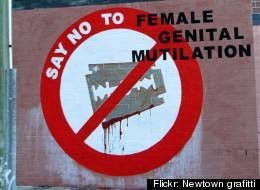
Ban FGM.
In her 2014 TED Talk, Khadija Gbla expresses the cultural friction she felt between two very different definitions of what it means to be “empowered.” Gbla recounts her experience growing up in Sierra Leone, a country where, like in Nigeria, female genital mutilation is a deeply valued cultural practice. Her mother, she recalls, insisted that she undergo the procedure in order to curb promiscuity, increase her marriageability, and more fully realize her womanhood.
Female Genital Mutilation is defined by the World Health Organization (WHO) as all procedures that involve partial or total removal of the external female genitalia. The data on physical and psychological consequences is horrifying. An inter-agency statement issued by the WHO and UNICEF, among others, states that when “seen from a human rights perspective, the practice reflects deep-rooted inequality between the sexes, and constitutes an extreme form of discrimination against women. FGM is nearly always performed on minors and is therefore a violation of the rights of the child. The practice also violates the rights to health, security and physical integrity of the person, the right to be free from torture and cruel, inhuman or degrading treatment, and the right to life when the procedure results in death.”
Approximately 100 to 115 million women worldwide undergo such procedures, usually before they turn 15. According to UNICEF, Nigeria accounts for about one-quarter of this total and has the highest total absolute number of FGM reports worldwide.
Though the UN banned FGM globally in 2012, Nigeria had yet to take a universalized, legal stand on the practice until May 5th, 2015, when outgoing president Goodluck Jonathan signed the FGM ban into law under the The Violence Against Persons Act of 2015. The law aims to eliminate violence against women in both public and private life and sets standardized legal guidelines that organizations working to end FGM can use. It creates a system of accountability within the government as well and, in addition to prohibiting female genital mutilation, seeks to eliminate the forceful ejection of women from their homes and harmful widowhood practices. It also makes forced abandonment without financial support, substance attacks, incest and more illegal.
As Gbla’s story illustrates, however, community cooperation must go hand-in-hand with new legal action. When cultural beliefs associated with the practice are so deeply embedded and supported by both men and women alike, anyone departing from the norm may face condemnation, harassment, and ostracism. As 2005 UNICEF statistical report states, “FGM is a social convention governed by rewards and punishments which are a powerful force for continuing the practice. It is often practiced even when it is known to inflict harm upon girls because the perceived social benefits of the practice are deemed higher than its disadvantages.”
FGM is thought to be closely tied with qualities such as virtue and obedience — qualities that determine a girl’s marriage and, later on, qualities that compose her social value. This is where a shift needs to occur: marriage prospects should not eclipse the importance of physical health and no girl should be put at risk of death in the name of empowerment. Though Nigeria’s law is a positive step towards complete FGM elimination in the country, it must be coupled with efforts that target the root of the problem: harmful gender standards. Investment in community programs that educate families and local leaders on the dangers of FGM and elevate the status of women is key to complete elimination of the practice.

